Papers by Thierry Oberdorff
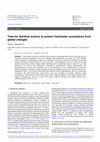
Knowledge & Management of Aquatic Ecosystems
Freshwater ecosystems and their biodiversity provide fundamental services to humans such as nutri... more Freshwater ecosystems and their biodiversity provide fundamental services to humans such as nutritional resources production, water provisioning, water purification, recreation, and more globally climate regulation. Anthropogenic impacts on freshwater ecosystems and their biodiversity are already strong and will most probably increase in the near future. Anthropogenic drivers are widely known and include in particular, climate change, habitat shrinking and/or modification due to land-use (e.g. water abstraction for human and agricultural consumption, urbanization), habitat fragmentation and homogenization in stream flow dynamics due to the damming of rivers, introduction of non-native species, dumping of nutrient or organic loadings increasing eutrophication processes, and biodiversity over-exploitation. Here, I review the current and future effects of these anthropogenic drivers on freshwater ecosystems and their biodiversity and provide some few examples of existing solutions, eit...

Conservation Science and Practice
The Amazon Basin features a vast network of healthy, free‐flowing rivers, which provides habitat ... more The Amazon Basin features a vast network of healthy, free‐flowing rivers, which provides habitat for the most biodiverse freshwater fauna of any basin globally. However, existing and future infrastructure developments, including dams, threaten its integrity by diminishing river connectivity, altering flows, or changing sediment regimes, which can impact freshwater species. In this study, we assess critical rivers that need to be maintained as freshwater connectivity corridors (FCCs) for selective freshwater species—long‐distance migratory fishes and turtles (both with migrations >500 km) and river dolphins. We define FCCs as river stretches of uninterrupted river connectivity that provide important riverine and floodplain habitat for long‐distance migratory and other species and that maintain associated ecosystem functions. We assessed more than 340,000 km of river, beginning with an assessment of the connectivity status of all rivers and then combining river status with models o...

The Amazon floodplains represent important surfaces of highly valuable ecosystems, yet they remai... more The Amazon floodplains represent important surfaces of highly valuable ecosystems, yet they remain neglected from protected areas. While the efficiency of the protected area network of the Amazon basin may be jeopardised by climate change, floodplains are exposed to important consequences of climate change but are omitted from species distribution models and protection gap analyses. We modelled the current and future (2070) distribution of the giant bony-tongue fish Arapaima sp. accounting for climate and habitat requirements, with consideration of dam presence (already existing and planned constructions) and hydroperiod (high- and low-water stages). We further quantified the amount of suitable environment which falls inside and outside the current network of protected areas to identify spatial conservation gaps. We predict climate change to cause the decline of environmental suitability by 16.6% during the high-water stage, and by 19.4% during the low-water stage. We found that abo...
HAL (Le Centre pour la Communication Scientifique Directe), 2001
HAL (Le Centre pour la Communication Scientifique Directe), Mar 14, 2018

The Scientific Outcome was produced by participants in the first-ever IPCC-IPBES co-sponsored wor... more The Scientific Outcome was produced by participants in the first-ever IPCC-IPBES co-sponsored workshop which took place in December 2020. This workshop is placed in the context of recent international agreements including the Paris Agreement, the Strategic Plan for Biodiversity 2011-2020 and ongoing preparation for the post-2020 global biodiversity framework, the Sendai Framework for Disaster Risk Reduction and the 2030 Agenda for Sustainable Development that converge on solving the dual crises of climate change and biodiversity loss as essential to support human well-being. The Scientific Outcome further develops and substantiates the conclusions of the Synopsis, summarizes the emerging state of knowledge involving climate change and biodiversity with the objective to inform decision making and highlight options for action, and to identify knowledge gaps to be filled by scientific research. The Scientific Outcome includes seven sections, the references outlining the evidence review...
The Synopsis presents the main conclusions of the first-ever IPCC-IPBES co-sponsored workshop whi... more The Synopsis presents the main conclusions of the first-ever IPCC-IPBES co-sponsored workshop which took place in December 2020. The workshop explored diverse facets of the interaction between climate and biodiversity, from current trends to the role and implementation of nature-based solutions and the sustainable development of human society. This Synopsis is underpinned by the Scientific Outcome, which includes seven sections, the complete references and the report glossary. You can find the Scientific Outcome here https://doi.org/10.5281/zenodo.4659158
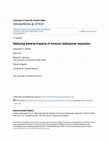
Science, 2022
Proposed hydropower dams at more than 350 sites throughout the Amazon require strategic evaluatio... more Proposed hydropower dams at more than 350 sites throughout the Amazon require strategic evaluation of trade-offs between the numerous ecosystem services provided by Earth’s largest and most biodiverse river basin. These services are spatially variable, hence collective impacts of newly built dams depend strongly on their configuration. We use multiobjective optimization to identify portfolios of sites that simultaneously minimize impacts on river flow, river connectivity, sediment transport, fish diversity, and greenhouse gas emissions while achieving energy production goals. We find that uncoordinated, dam-by-dam hydropower expansion has resulted in forgone ecosystem service benefits. Minimizing further damage from hydropower development requires considering diverse environmental impacts across the entire basin, as well as cooperation among Amazonian nations. Our findings offer a transferable model for the evaluation of hydropower expansion in transboundary basins.
Zipped file containing csv tables with information on the global distribution of freshwater fish ... more Zipped file containing csv tables with information on the global distribution of freshwater fish species functional traits, basin occurrences, and taxonomic and functional indices.
This document contains the draft Chapter 4 of the IPBES Global Assessment on Biodiversity and Eco... more This document contains the draft Chapter 4 of the IPBES Global Assessment on Biodiversity and Ecosystem Services. Governments and all observers at IPBES-7 had access to these draft chapters eight weeks prior to IPBES-7. Governments accepted the Chapters at IPBES-7 based on the understanding that revisions made to the SPM during the Plenary, as a result of the dialogue between Governments and scientists, would be reflected in the final Chapters.IPBES typically releases its Chapters publicly only in their final form, which implies a delay of several months post Plenary. However, in light of the high interest for the Chapters, IPBES is releasing the six Chapters early (31 May 2019) in a draft form. Authors of the reports are currently working to reflect all the changes made to the Summary for Policymakers during the Plenary to the Chapters, and to perform final copyediting.
Journal of Biogeography, 2021
Phylogenetic relatedness among species can provide useful information on the diversification hist... more Phylogenetic relatedness among species can provide useful information on the diversification history and past dispersal events that may have shaped contemporary assemblages. Here, using of the most comprehensive fish occurrence database currently available and a global molecular phylogeny of ray‐finned fishes, we evaluate the respective roles of historical and contemporary processes in generating and maintaining fish assemblage phylodiversity patterns among 97 sub‐drainages covering the Amazon River basin.
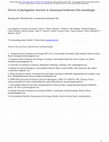
ABSTRACTAimCommunity phylogenetics provides important information about the evolutionary and ecol... more ABSTRACTAimCommunity phylogenetics provides important information about the evolutionary and ecological factors help structure regional species assemblages. Here, we analyze phylogenetic diversity (phylodiversity) patterns among fish species in 97 sub-drainages of the Amazon basin, to evaluate the roles of historical and contemporary processes in generating and maintaining the exceptional richness and endemism of Amazonian fish species assemblages.LocationAmazon River basinTaxonFreshwater fishesMethodsUsing a large comprehensive database of freshwater fish species distributions, and a well-sampled molecular phylogeny of ray-finned (actinopterygian) fishes, we develop of multivariate statistical model to correlate estimated historical and contemporary environmental parameters with sub-drainage phylodiversity patterns. The model employs three phylogenetic metrics: i.e.: phylogenetic diversity (PD) sensu stricto, mean pairwise phylogenetic distance (MPD) between species capturing phylo...

Freshwater habitats are vitally important for vertebrate diversity and ecosystem service provisio... more Freshwater habitats are vitally important for vertebrate diversity and ecosystem service provision. These habitats are diverse in scale and type, ranging from vast wetlands and tropical flooded forests to small streams and ponds, but are all equally important to the diverse range of vertebrates they support. The loss and degradation of freshwater habitats globally, largely driven by agricultural intensification, land-use change and deforestation, threatens vertebrates and the continued functioning of freshwater ecosystems. Well-informed, evidence-based conservation is reliant on suitably designed surveys capable of detecting population changes in target species. Due to the diversity and complexity of freshwater habitats and their associated vertebrate taxa a comprehensive review of all methods for all species is beyond the scope of this chapter. However, here we outline key considerations and methods for surveying vertebrates in freshwater systems and provide signposts to relevant c...
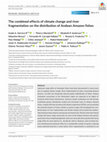
Global Change Biology, 2020
Upstream range shifts of freshwater fishes have been documented in recent years due to ongoing cl... more Upstream range shifts of freshwater fishes have been documented in recent years due to ongoing climate change. River fragmentation by dams, presenting physical barriers, can limit the climatically induced spatial redistribution of fishes. Andean freshwater ecosystems in the Neotropical region are expected to be highly affected by these future disturbances. However, proper evaluations are still missing. Combining species distribution models and functional traits of Andean Amazon fishes, coupled with dam locations and climatic projections (2070s), we (a) evaluated the potential impacts of future climate on species ranges, (b) investigated the combined impact of river fragmentation and climate change and (c) tested the relationships between these impacts and species functional traits. Results show that climate change will induce range contraction for most of the Andean Amazon fish species, particularly those inhabiting highlands. Dams are not predicted to greatly limit future range shi...
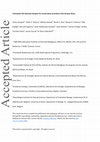
Conservation Biology, 2020
Conserving freshwater habitats and their biodiversity in the Amazon Basin is a growing challenge ... more Conserving freshwater habitats and their biodiversity in the Amazon Basin is a growing challenge in the face of rapid anthropogenic changes. We used the most comprehensive fish‐occurrence database available (2355 valid species; 21,248 sampling points) and 3 ecological criteria (irreplaceability, representativeness, and vulnerability) to identify biodiversity hotspots based on 6 conservation templates (3 proactive, 1 reactive, 1 representative, and 1 balanced) to provide a set of alternative planning solutions for freshwater fish protection in the Amazon Basin. We identified empirically for each template the 17% of sub‐basins that should be conserved and performed a prioritization analysis by identifying current and future (2050) threats (i.e., degree of deforestation and habitat fragmentation by dams). Two of our 3 proactive templates had around 65% of their surface covered by protected areas; high levels of irreplaceability (60% of endemics) and representativeness (71% of the Amazo...
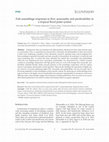
Ecosphere, 2018
Hydropower dams are looming in the Mekong Basin, affecting river flows that structure aquatic com... more Hydropower dams are looming in the Mekong Basin, affecting river flows that structure aquatic communities. Here, we quantitatively assessed flow seasonality and predictability in three sites located in three rivers displaying a gradient in flow alterations caused by upstream dams and investigated how fish assemblages responded seasonally and inter‐annually to this gradient. By analyzing 7‐yr daily fish and water monitoring data, we found that dams disturbed the natural flow seasonality and predictability. While the river displaying the lower seasonality–predictability was characterized by a distinct seasonal variation in assemblage composition with high species turnover, rivers with stronger flow seasonality–predictability exhibited broadly similar seasonal patterns in fish assemblage composition with low species turnover and regular annual peaks of fish migration. These results challenge the expectation of higher species turnover in systems displaying higher flow seasonality and pr...
Journal of Applied Ichthyology, 2015
With around 15% of all described freshwater fish species in the world, the Amazon Basin is by far... more With around 15% of all described freshwater fish species in the world, the Amazon Basin is by far the most fish speciesrich freshwater ecosystem on the planet. In this opinion paper, a rough evaluation is given on just how vulnerable Amazonian freshwater fishes are to ongoing climate change. And to argue that current anthropogenic threats through rapid expansion of human infrastructure and economic activities in the basin could be a far greater threat to fish communities than those anticipated by any future climate change. Conservation actions in the Amazon Basin should focus preferentially on reducing the impacts of present-day anthropogenic threats.
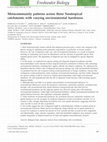
Freshwater Biology, 2016
Summary Most metacommunity studies indicate that dispersal processes play a minor role compared w... more Summary Most metacommunity studies indicate that dispersal processes play a minor role compared with species sorting in explaining metacommunity organisation, in particular, in stream systems. However, the role of dispersal could vary with environmental harshness, as a result of frequent resetting of community succession by disturbances and the selection of generalist species from regional species pools. The importance of dispersal may also be mitigated by species dispersal ability. In this study, we explored how species sorting and dispersal shaped invertebrate and fish metacommunities across streams in three tropical headwater catchments in Bolivia with contrasting environmental harshness, including flow regime, altitude and climate conditions. We addressed the hypothesis that the relative roles of dispersal and species sorting vary with environmental harshness: we predicted that the role of species sorting would predominate in benign conditions, whereas that of dispersal would pr...











Uploads
Papers by Thierry Oberdorff